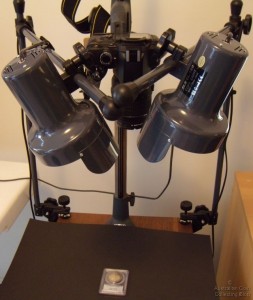We’ve spent years striving to perfect the art of taking quality coin images. Over the years we’ve upgraded parts of our setup and we’re finally at that point where we’re happy with the images we take and happy that they portray the coins as they are without the need for photoshop or artificial manipulation. We use 2 different methods of coin photography. The first is to use a Dinolite Microscope for extreme closeup shots which we’ve discussed previously in the entry Dino-Lite USB Microscopes and Coins. We also have a digital SLR for images of entire coins not requiring magnified close-up. The Dinolite won’t image an entire coin unless it’s threepence size and the built in lighting is very poor for imaging an entire coin.
Our digital SLR is a Nikon D7100 D60 with 24 10.2 megapixel resolution. We mostly use a Tamron 90mm fixed length macro lens for coins but interchange it with one of it’s original lenses, a Nikon 18-55mm lens. This lens is used for shots of larger items such as PNC’s and mintsets. The camera sits on a copystand we picked up secondhand from a camera shop and is movable up and down. Clipped on either side of the copystand are 2 lights with swivel arms and shrouds to direct the light. Using 2 PAR 30 100w halogen spotlights the serious light is serious enough to fry an egg! We control the camera from a PC running the free DSLR controlling digiCamControlNikon’s nifty Camera Control 2 software. So what it comes down to now is place the coin under the camera and click via the keyboard!
Update 27 November 2015 – updated the article to include the details of our current DSLR body and the software we use to control the camera these days.


